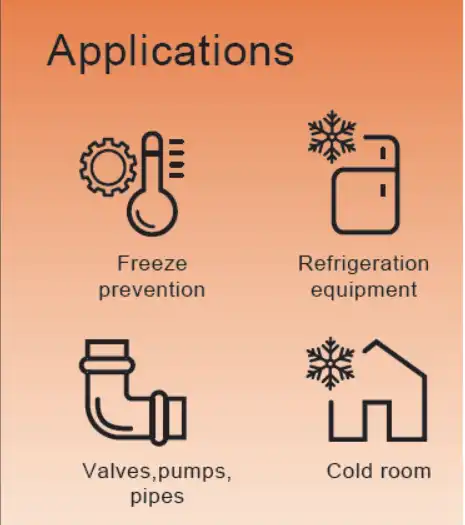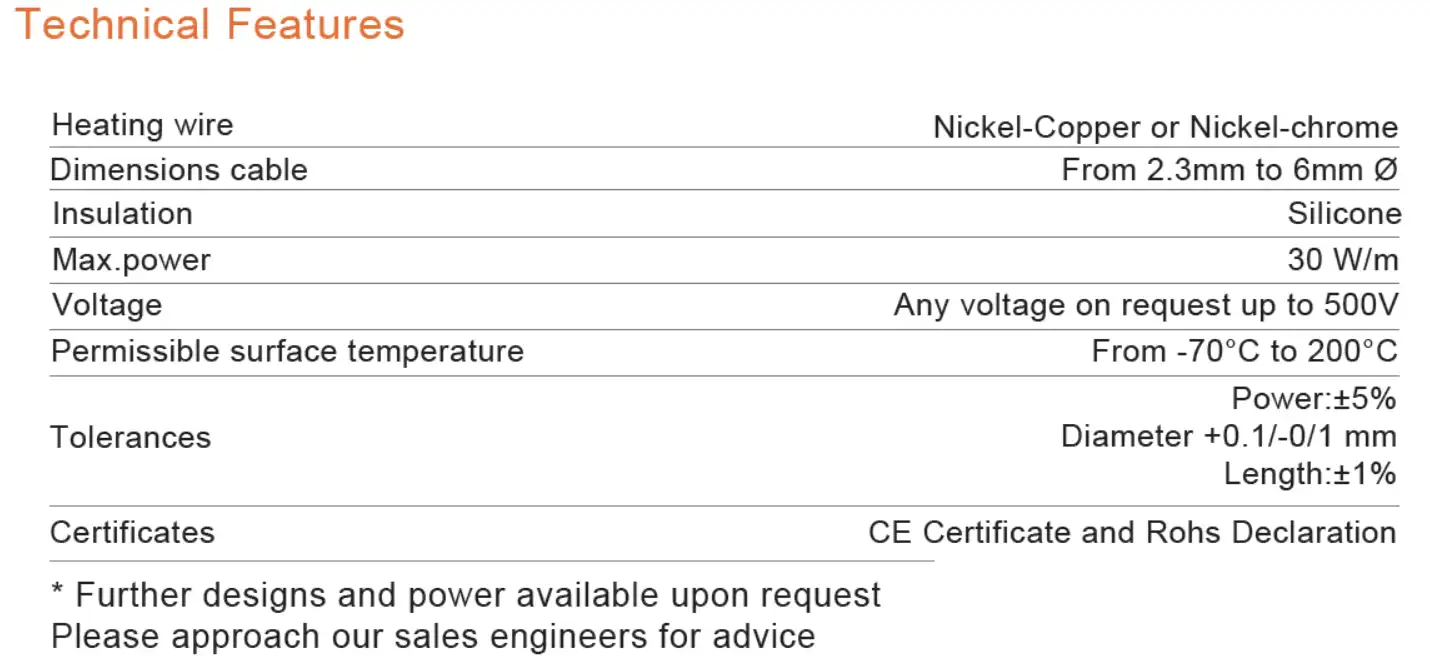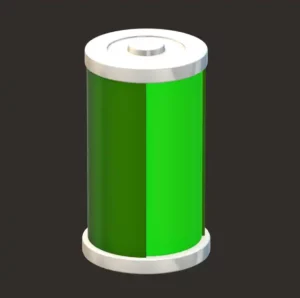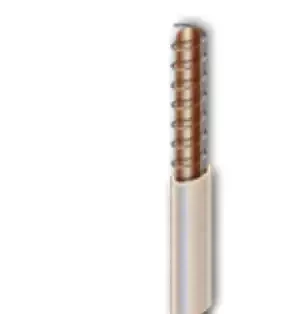Description
Heating cable with two power ratings is a versatile and efficient solution for maintaining optimal temperatures in various applications. Heating cable with two power ratings is designed to offer flexibility in controlling heat output, allowing users to adjust their power settings based on specific needs or environmental conditions.
One of the primary advantages of heating cable with two power ratings is its adaptability to different heating requirements. Heating cable with two power ratings typically come with two selectable power settings, enabling users to switch between high and low heat outputs as necessary. This feature is particularly useful in scenarios where temperature fluctuations are common or when energy conservation is a priority.
In industrial settings, heating cable with two power ratings find applications in freeze protection, process temperature maintenance, and snow melting systems. The ability to toggle between power ratings allows for energy-efficient operation during milder weather conditions and enhanced heating performance during extreme cold spells. This adaptability not only contributes to energy savings but also extends the lifespan of the heating cable system.
In residential and commercial settings, heating cable with two power ratings is commonly used for pipe freeze protection, roof and gutter de-icing, and floor heating applications. Homeowners and facility managers benefit from the flexibility to choose the appropriate power level based on weather forecasts or specific heating requirements.
Additionally, the installation and operation of heating cable with two power ratings is user-friendly. With simple controls and easy-to-understand interfaces, users can confidently manage the system without the need for complex configurations.
In summary, heating cable with two power ratings provide a versatile and energy-efficient solution for maintaining optimal temperatures in diverse environments. Their adaptability, ease of use, and ability to balance energy consumption make them a reliable choice for a wide range of heating applications.
Characteristics of heating cable with two power ratings:
Silicone series type heating cable with two power ratings
Possibility of incorporating up to two different power ratings
Excellent connection surface
Power supply: Up to 30 W/m
On request up to 500 V
Where can you use Heating Cable with Two Power Rating?

Heating cable with two power ratings find versatile applications across various industries and residential settings, offering a flexible solution for maintaining optimal temperatures in different environments. The dual power capability of these cables makes them suitable for a wide range of applications, providing users with the ability to adjust heat output based on specific needs and prevailing conditions.
In industrial settings, heating cable with two power ratings are commonly employed for freeze protection, process temperature maintenance, and snow melting systems. These applications are crucial in ensuring the smooth operation of equipment and processes in challenging climates.
For instance, in pipelines exposed to extreme cold, these cables help prevent freezing, ensuring a continuous flow of liquids and preventing damage to the infrastructure. The dual power feature allows for energy-efficient operation during milder conditions, minimizing power consumption without compromising on the effectiveness of freeze protection.
In manufacturing facilities, heating cable with two power ratings is utilized to maintain optimal temperatures in various processes, such as chemical production and petrochemical refining. The ability to switch between high and low power settings enables the system to adapt to fluctuations in ambient temperatures, providing efficient heating when needed and conserving energy during less demanding periods.
Snow melting systems on driveways, walkways, and ramps also benefit from heating cables with dual power ratings. In regions where snow and ice accumulation pose safety hazards, these cables ensure the timely removal of frozen precipitation, enhancing safety for pedestrians and vehicles.
The flexibility to adjust power levels allows users to customize the system’s performance based on the severity of weather conditions, optimizing energy usage while effectively preventing snow and ice buildup.
In residential and commercial settings, heating cable with two power ratings are commonly used for pipe freeze protection, roof and gutter de-icing, and floor heating applications. When applied to pipes, these cables prevent freezing, safeguarding plumbing systems from potential damage caused by ice formation.
Roof and gutter de-icing systems utilize the dual power feature to efficiently melt snow and ice, preventing ice dams and the associated risks of water damage to buildings.
Floor heating systems benefit from the flexibility of dual power ratings, offering users the ability to customize the warmth of different living spaces. Whether it’s a high heat output for quick warming during colder months or a lower setting for milder temperatures, these heating cables provide year-round comfort with energy-efficient operation.
The installation and operation of heating cable with two power ratings is user-friendly, making them accessible to a wide range of users. With intuitive controls and straightforward interfaces, both homeowners and industrial operators can manage the system effectively without extensive technical expertise.
In conclusion, heating cable with two power ratings offers versatile solutions for a multitude of applications. From industrial processes to residential comfort, these cables provide adaptability, energy efficiency, and reliable temperature control, making them indispensable in ensuring the functionality, safety, and comfort of diverse environments.
These are series flexible resistors offering the possibility of incorporating up to two
different power ratings.
It is used in specific applications where it is required to obtain different temperatures
with the same resistor. Inactive areas can be incorporated.
Cable structure: Silicone insulation series type heating cable with up to two different
power ratings.
Why should you choose Heating Cables with Two Power Rating?

Choosing heating cable with two power ratings offers a range of benefits, making them a preferred solution for various applications. The dual power capability of these cables provides users with flexibility, energy efficiency, and adaptability, making them a versatile choice in maintaining optimal temperatures in diverse environments.
One of the key advantages of heating cable with two power ratings is their adaptability to changing weather conditions. In regions experiencing temperature fluctuations, these cables allow users to easily switch between high and low power settings based on the severity of the weather.
This adaptability ensures that the heating system can efficiently respond to changing environmental demands, providing effective temperature control when needed and conserving energy during milder conditions. This feature is particularly valuable in industrial settings where processes may operate under different temperature requirements throughout the year.
Energy efficiency is another compelling reason to choose heating cable with two power ratings. The ability to adjust the power output based on specific needs allows users to optimize energy consumption.
During periods of lower demand or milder weather, selecting the lower power setting can result in substantial energy savings without compromising the system’s effectiveness. This not only contributes to cost savings but also aligns with sustainability goals by reducing overall energy consumption.
Versatility in application is a significant factor that makes heating cable with two power ratings an attractive choice. Whether used for freeze protection in pipelines, maintaining process temperatures in manufacturing facilities, or preventing snow and ice buildup on driveways and walkways, the dual power capability ensures that the cables can be tailored to suit a wide range of requirements.
This versatility makes them a cost-effective and practical solution for various industries and residential settings.
Heating cable with two power ratings are also known for their ease of installation and operation. The user-friendly design and straightforward controls make them accessible to a wide range of users, from homeowners to industrial operators.
The simplicity of the interface allows for convenient adjustment of power settings, ensuring that the system is easily manageable without the need for extensive technical expertise. This ease of use contributes to the overall appeal of these heating cables as a reliable and efficient solution.
The adaptability of dual power ratings extends the lifespan of heating cable systems. By allowing users to modulate power levels based on seasonal demands or specific heating requirements, heating cable with two power ratings experiences less strain and wear. This not only enhances the longevity of the cables but also reduces the frequency of maintenance and replacement, resulting in cost savings over the long term.
In conclusion, choosing heating cable with two power ratings is a prudent decision for those seeking a versatile, energy-efficient, and adaptable solution for maintaining optimal temperatures.
The ability to customize power settings, coupled with ease of installation and operation, makes these cables suitable for a wide range of applications in both industrial and residential settings. Whether prioritizing energy efficiency, flexibility, or ease of use, heating cables with dual power ratings offer a comprehensive solution for effective temperature control in diverse environments.
Why should you choose SVR Trace for purchasing Heating Cables with Two Power Rating?

Choosing SVR Trace for purchasing heating cable with two power ratings presents a compelling case for those seeking reliable, high-quality solutions for temperature control in diverse applications. SVR Trace stands out as a preferred supplier for several reasons, ranging from their commitment to product excellence to their customer-centric approach and industry expertise.
First and foremost, SVR Trace has built a reputation for delivering high-quality heating cables with two power ratings. The company places a strong emphasis on product excellence, ensuring that their heating cable with two power ratings meets stringent quality standards.
This commitment to quality is reflected in the durability, reliability, and performance of SVR Trace’s products, providing customers with confidence in the longevity and effectiveness of their heating solutions.
SVR Trace’s heating cable with dual power ratings are designed to offer versatility and adaptability, catering to a wide range of applications. Whether for industrial freeze protection, process temperature maintenance, or residential roof and gutter de-icing, SVR Trace’s products provide the flexibility needed to address diverse heating requirements.
This versatility makes SVR Trace a go-to choice for customers seeking a supplier that can meet their specific needs across various industries.
The company’s dedication to energy efficiency sets SVR Trace apart in the market. The heating cable with two power ratings offered by SVR Trace enable users to optimize energy consumption by adjusting power levels based on seasonal demands or specific heating requirements.
This commitment to energy efficiency aligns with modern sustainability goals and positions SVR Trace as a responsible and forward-thinking supplier in the field of temperature control solutions.
SVR Trace’s customer-centric approach is another reason why it is a preferred choice for purchasing heating cables. The company prioritizes customer satisfaction by providing personalized support, technical assistance, and guidance throughout the purchasing process.
SVR Trace understands the unique needs of its customers and works collaboratively to find tailored solutions, ensuring that clients receive not only high-quality products but also the support necessary for successful implementation.
Industry expertise is a cornerstone of SVR Trace’s offerings. With a team of experienced professionals, the company stays abreast of industry trends, technological advancements, and evolving customer needs.
This depth of knowledge allows SVR Trace to provide expert advice, recommend suitable products for specific applications, and anticipate emerging requirements in the field of heating cables with two power ratings.
SVR Trace’s commitment to innovation is evident in its product development and continuous improvement efforts. The company invests in research and development to stay at the forefront of technological advancements, ensuring that its heating cables incorporate the latest features and improvements.
This dedication to innovation positions SVR Trace as a reliable supplier that evolves with industry demands, offering cutting-edge solutions to its customers.
In conclusion, choosing SVR Trace for purchasing heating cable with two power ratings is a strategic decision rooted in the company’s commitment to product excellence, versatility, energy efficiency, customer satisfaction, industry expertise, and innovation.
As a reliable and forward-thinking supplier, SVR Trace provides customers with not only high-quality products but also the support and expertise needed for successful temperature control solutions in various applications.
What are Technical Features of Heating Cable with Two Power Rating?

How much power does a Heating Cable with Two Power Rating use?

The power consumption of a heating cable with two power ratings can vary based on several factors, including the selected power setting, the length of the cable, and the specific application. These cables are designed to provide flexibility in terms of power output, allowing users to choose between two different levels depending on their heating requirements and prevailing environmental conditions.
The dual power ratings typically consist of a higher and a lower setting, giving users the ability to adjust the heat output based on the demands of the situation. The power consumption will vary depending on whether the cable is operating at the higher or lower power setting.
Generally, the higher power setting is utilized during more severe cold weather conditions, providing maximum heat output for effective temperature control. Conversely, the lower power setting is employed during milder conditions or when energy conservation is a priority.
The power consumption of a heating cable is measured in watts per unit length, and the total power usage is determined by multiplying this value by the length of the cable in meters or feet.
For example, if a heating cable has a power output of 10 watts per foot and is 50 feet long, the total power consumption would be 500 watts when operating at that specific power setting.
It’s important to note that the overall energy usage of heating cable with two power ratings is influenced by how and when they are utilized. These cables are designed to be energy-efficient, allowing users to tailor the heat output to match the specific requirements of the application.
During periods of lower demand or when a lower temperature maintenance is sufficient, selecting the lower power setting can result in significant energy savings.
Additionally, the power consumption of these cables is affected by the insulation and environmental conditions. Well-insulated systems can retain heat more effectively, reducing the overall energy needed to maintain the desired temperature. Factors such as ambient temperature, wind exposure, and the presence of insulation all play a role in determining the cable’s power usage.
In summary, the power consumption of a heating cable with two power ratings is dynamic and depends on various factors, including the selected power setting, cable length, insulation, and environmental conditions. These cables are designed to offer flexibility, allowing users to choose the appropriate power level based on their specific heating requirements.
As a result, the overall power usage can be optimized for energy efficiency, making these cables a versatile and cost-effective solution for temperature control in diverse applications. It is advisable to consult the manufacturer’s specifications and guidelines to ensure proper usage and to determine the specific power consumption of a particular heating cable model.
How many amps does a Heating Cable with Two Power Rating draw?
The amperage drawn by a Heating Cable with Two Power Ratings depends on the specific power setting selected during operation. These cables typically offer users the flexibility to choose between two power levels, which directly influences the amount of current drawn.
When operating at the higher power setting, the heating cable will draw a higher amperage, providing increased heat output for more demanding temperature control needs. Conversely, when set to the lower power rating, the amperage drawn is reduced, allowing for energy-efficient operation during milder conditions or when lower heat output is sufficient.
To determine the exact amperage drawn by a Heating Cable with Two Power Ratings, it is essential to refer to the product specifications provided by the manufacturer. The specifications typically include details such as power ratings, voltage requirements, and corresponding amperages for each power setting.
For instance, a heating cable may have a high power setting that draws, for example, 10 amps, and a low power setting that draws 5 amps. Users can then choose the appropriate power level based on their heating requirements, allowing for a balance between effective temperature control and energy conservation.
It’s crucial for users to follow the manufacturer’s guidelines and specifications to ensure safe and optimal operation of the heating cable system. This includes adhering to recommended power settings and electrical requirements to prevent overloading circuits and to maintain the longevity of the heating cable.
In summary, the amperage drawn by a Heating Cable with Two Power Ratings is contingent on the specific power setting selected by the user. This flexibility allows for efficient energy usage, making these cables suitable for diverse applications where temperature control needs may vary. Always refer to the manufacturer’s specifications for accurate information on amperage and other electrical requirements.
How many watts is a Heating Cable with Two Power Rating?
The wattage of a heating cable with two power ratings can vary depending on the specific model and its design. These cables are engineered to offer flexibility in heat output, typically providing users with the option to choose between two different power levels.
The power ratings are often expressed in watts per unit length, such as watts per foot or wattage per meter.
For example, a heating cable might have a dual power rating of 5 watts per foot on the high setting and 3 watts per foot on the low setting.
This means that when operating at the high setting, the cable will consume 5 watts of power per linear foot, and at the low setting, it will use 3 watts per linear foot.
The ability to switch between these power levels provides users with control over the amount of heat generated, allowing for energy-efficient operation based on specific heating requirements or environmental conditions.
It’s crucial for users to consult the product specifications and technical documentation provided by the manufacturer to determine the exact wattage and power ratings of a specific heating cable.
This information ensures that the heating cable with two power ratings is appropriately sized and configured for the intended application, whether it’s freeze protection for pipes, roof and gutter de-icing, or floor heating in residential, commercial, or industrial settings.
Understanding the wattage of a heating cable with two power ratings is essential for optimizing energy efficiency and achieving effective temperature control in diverse environments.
Heating Cable with Two Power Rating price

The pricing of a heating cable with two power ratings can vary based on several factors, including the brand, length of the cable, power capacity, and additional features. Typically, these cables are priced per linear foot or meter, with longer cables generally costing more due to the increased material and manufacturing requirements.
Brands with a reputation for quality and reliability may command higher prices, reflecting the assurance of a durable and efficient heating solution. Additionally, cables with advanced features or specifications may have a higher price point. The dual power rating capability, which allows users to switch between high and low power settings, contributes to the versatility of the cable and may influence the overall cost.
Installation complexity and requirements can also impact the price. Some heating cables may come with accessories, such as programmable thermostats or sensors, which can add to the overall cost but enhance the system’s efficiency and user experience.
It’s advisable to obtain quotes from reputable suppliers or manufacturers of heating cable with two power ratings, ensuring that the pricing includes all necessary components for a complete and functional heating system.
Additionally, considering the long-term energy savings and efficiency benefits provided by these cables, the upfront investment is often justified by the improved control and adaptability they offer in maintaining desired temperatures.

